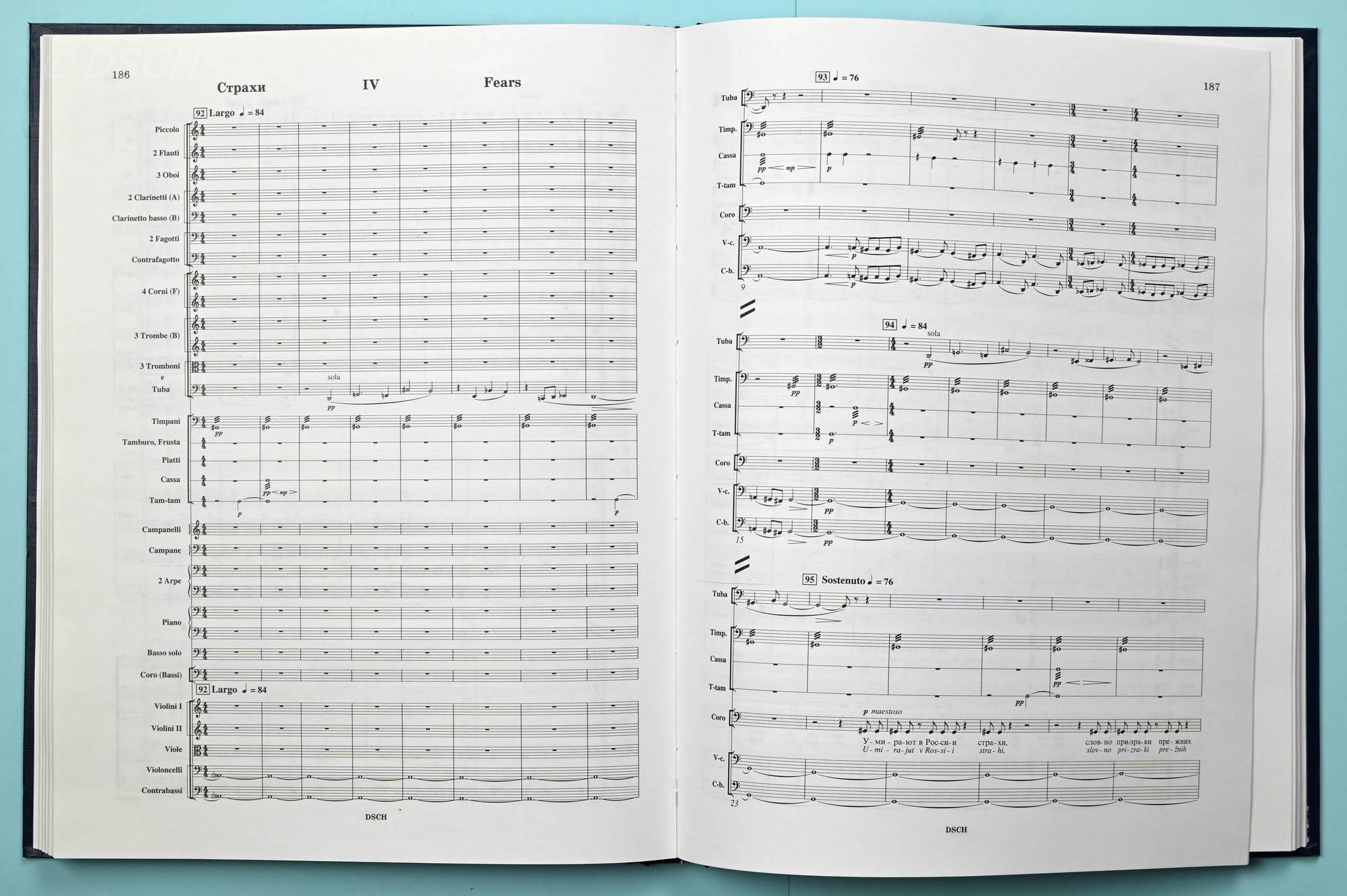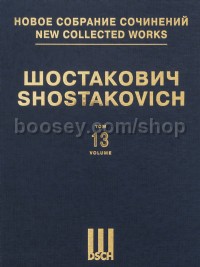Symphony No. 13 Op113 - Full Score (New Collected Works vol.13)
Symphony No. 13 Op113 - Full Score (New Collected Works vol.13)
* Estimated price converted from UK retail price
Click below to view music sample pages


In the spring of 1962, the composer finished his one-movement composition to Yevtushenko’s words: Symphonic Poem “Babi Yar” for Bass, Bass Choir, and Orchestra, Op. 113. The rough draft was finished on 23 March 1962, the piano score on 27 March, and the orchestral score on 21 April, but by this time the idea for the composition had expanded. The composer wanted to put a few more of Yevtushenko’s poems to music, in addition to “Babi Yar”. After he made the poet’s acquaintance, Shostakovich asked him about his creative work and suggested a few themes of his own. This is how a paradoxical situation extremely uncharacteristic of the composer developed: thinking over ways to perform the new composition he had already finished, he also became carried away with how to continue developing it. So by the end of June, the author saw the composition either as a symphony, or as a cycle of “symphonic poems” with the participation of a choir and soloist, or as a vocal-symphonic suite in four movements. And it was indeed the 20th that the last page of the symphony score was dated. During his one-month stay in hospital, the composer wrote all four new movements of the score: “Humour” was finished on 5 July, “In the Shop” on 9 July, “Fears” on 16 July, and “A Career” on 20 July. On 3 August, Shostakovich wrote to Glikman that he was working on the symphony’s piano arrangement in four hands. Then the piano score for singing with the piano was written. On 13 August 1962, three days before he left for the Edinburgh Festival, the composer let Levon Atovmian know, “I have finished the 13th Symphony”, meaning, apparently, he had completed the entire work, including the four-hand arrangement and the piano score.
The story of how the score and piano score of the Thirteenth Symphony were published is closely related to the story of its performance. As we know, the premiere of the Symphony aroused an extremely negative official reaction, which was expressed in the press reviews, and there was an unofficial ban not only on its performance, but also on any distribution of it, including, of course, its recording and publication. The authorities demanded that the composer make changes to the first movement of the composition (“Babi Yar”) in keeping with the new text of the poem published by Yevgeny Yevtushenko. The composer refused to make any alterations to his composition, but at Kirill Kondrashin’s request, in order not to disrupt the performances of the symphony scheduled for 11 and 12 February 1963, he agreed to replace eight lines of Yevtushenko’s text with new ones. The score of the symphony was not printed in the Soviet Union until 1971, nine years after the premiere. It was published with the same two altered quatrains. The piano score of the symphony was not published in the Soviet Union during Shostakovich’s lifetime. In 2006, in celebration of the one hundredth anniversary of the composer’s birth, DSCH Publishers put out a facsimile of the author’s manuscript of the score of the Thirteenth Symphony featuring the original text of the symphony. This publication is based on the author’s manuscript of the score kept in Dmitri Shostakovich’s Archive.
Instrumentation:
Piccolo, 2 Flutes, 3 Oboes (III = Cor anglais), 3 Clarinets (B flat and A; III = E flat and Bass), 3 Bassoons (III = Contrabassoon), 4 Horns, 3 Trumpets, 3 Trombones, Tuba, Timpani, Triangle, Castanets, Wood block, Tambourine, Side drum, Whip, Cymbals, Bass drum, Gong, Campanelli, Campane, Xylofone, Celesta, Harp (2–4), Piano, Bass soloist, choir of 40–100 bass voices, 1st Violins (16–20), 2nd Violins (14–18), Violas (12–16), Double-basses (10–14 five-string specified)
This ambitious series by DSCH, the exclusive publisher of the works of Dmitri Shostakovich, when complete, will run to 150 volumes.
Based on authentic manuscripts, accompanied by commentaries in Russian and in English, each volume contains new engravings, articles relating to the history of the compositions, facsimile pages of Shostakovich's manuscripts, outlines, and rough drafts.
Divided into 15 different "series" or genres, the edition will include nearly all the original works of the composer, and his instrumentation of music by Domenico Scarlatti, Beethoven, Schubert, Schumann, Mussorgsky, Rimsky-Korsakov, Johann Strauss, Youmans, Braga, Tishchenko, and others.
25% of the New Collected Works will be made up of previously unpublished material: over 80 of his works are being published here for the first time. Many of these previously unknown works could not be published or performed during the composer's lifetime for ideological reasons.
The fifteen "series" within the edition comprise:
I: Symphonies (vols 1-30)
II: Orchestra Compositions (vols 31-37)
III: Instrumental Concertos (vols 38-49)
IV: Compositions for the Stage (vols 50-67)
V: Suites from Operas and Ballets (vols 68-72)
VI: Compositions for Choir and Orchestra (With or Without Soloists) (vols 73-83)
VII: Unaccompanied Choral Compositions/Arrangements of Russian Folksongs (vols 84-86)
VIII: Compositions for Solo Voice(S) With Orchestra (vols 87-90)
IX: Chamber Compositions for Voice and Songs (vols 91-97)
X: Chamber Instrumental Ensembles (vols 98-105)
XI: Instrumental Sonatas(vols 106-108)
XII: Piano Compositions (vols 109-115)
XIII: Incidental Music (vols 116-121)
XIV: Film Music (vols 122-145)
XV: The Works of Other Composers, Instrumentation by Shostakovich (vols 146-150)




